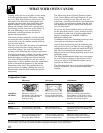
6
MICROWAVING TIPS
• Make sure all cookware used in your
microwave/convection oven is suitable for
microwaving. Most glass casseroles, cooking
dishes, measuring cups, custard cups, pottery or
china dinnerware which does not have metallic trim
or glaze with a metallic sheen can be used. Some
cookware is labeled ‘‘suitable for microwaving.’’
• If you are not
sure if a dish is
microwave-safe,
use this test:
Place in the oven
both the dish you
are testing and a
glass measuring
cup filled with
1 cup of water—
set the measuring cup either in or next to the dish.
Microwave 1 minute at high. If the dish heats,
it should not be used for microwaving. If the dish
remains cool and only the water in the cup heats,
then the dish is microwave-safe.
• Paper towels, waxed paper and plastic wrap
can be used to cover dishes in order to retain
moisture and prevent spattering. Be sure to vent
plastic wrap so steam can escape.
• Some microwaved foods require stirring, rotating
or rearranging.
• Steam builds up pressure in foods which are
tightly covered by a skin or membrane. Pierce
potatoes, egg yolks and chicken livers to prevent
bursting.
If you use a meat thermometer while cooking, make
sure it is safe for use in microwave ovens.
VARIABLE POWER LEVELS (1–10)
Variable power levels add flexibility to your microwave
cooking. The power levels on your microwave oven can
be compared to the surface units on a range. High
(Power Level 10) or full power is the fastest way to cook
and gives you 100% power. Each power level gives you
microwave energy a certain percent of the time. Power
Level 7 is microwave energy 70% of the time. Power
Level 3 is energy 30% of the time.
A high setting (10) will cook faster but may need
additional attention such as frequent stirring, rotating
or turning over. Most of your cooking will be done
on High (Power Level 10). A lower setting will cook
more evenly and with less attention given to stirring
or rotating the food. Some foods may have better
flavor, texture or appearance if one of the lower
settings is used. You may wish to use a lower power
level when cooking foods that have a tendency to
boil over, such as scalloped potatoes.
Rest periods (when the microwave energy cycles off)
give time for the food to “equalize” or transfer heat
to the inside of the food. An example of this is shown
with Power Level 3—the defrost cycle. If microwave
energy did not cycle off, the outside of the food
would cook before the inside was defrosted.
Here are some examples of uses for various power
levels:
POWER LEVEL BEST USES
High 10 Fish, bacon, vegetables,
boiling liquids.
Med-High 7 Gentle cooking of meat and
poultry; baking casseroles
and reheating.
Medium 5 Slow cooking and tenderizing
such as stews and less tender
cuts of meat.
Low 3 Defrosting without cooking;
simmering; delicate sauces.
Warm 1 Keeping food warm without
overcooking; softening butter.
How to Change Power Level
1. Press MICRO COOK or TIME DEFROST.
2. Select cooking or defrosting time.
3. Press POWER LEVEL.
4. Select desired power
level 1–10.
5. Press START.


















